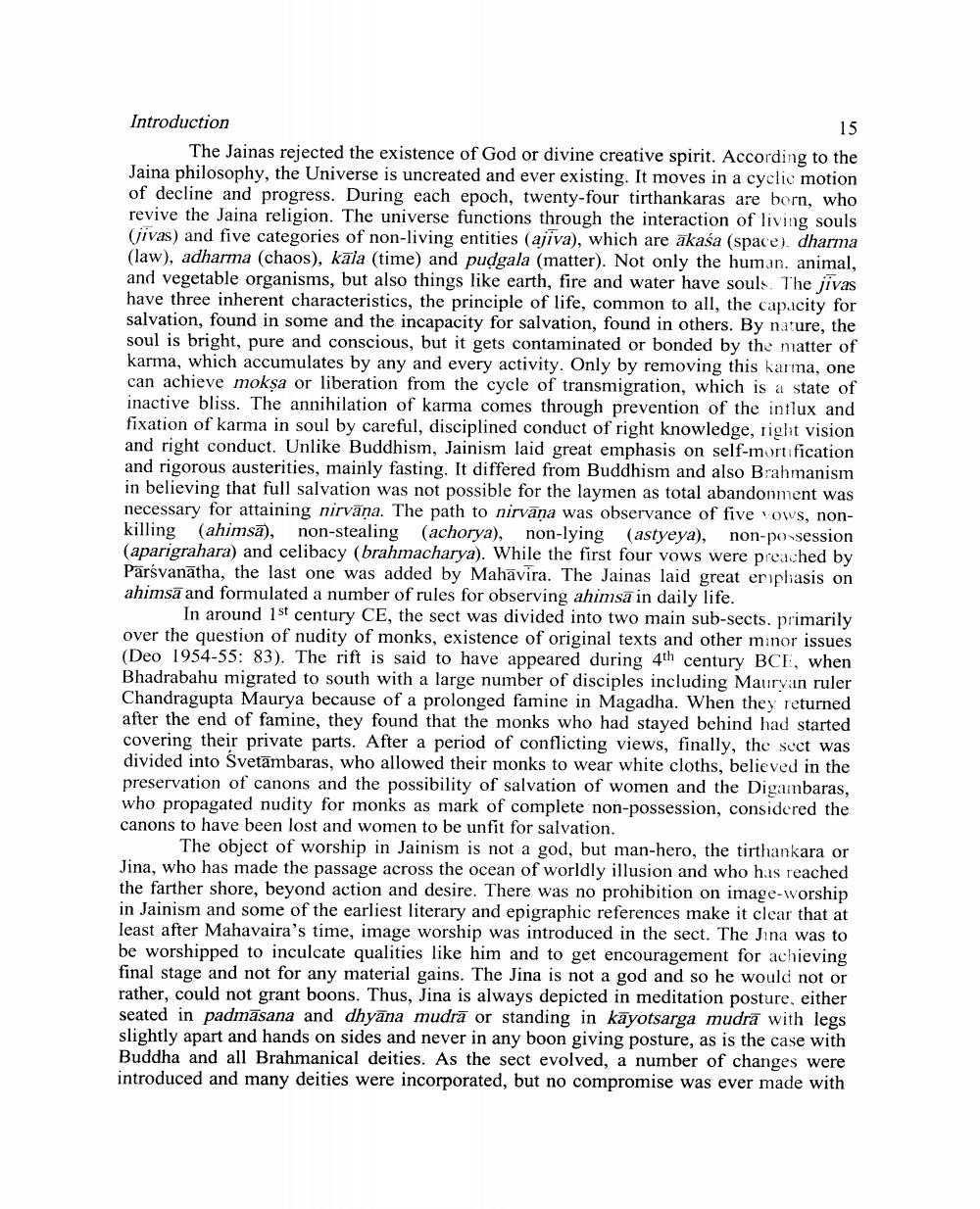________________
Introduction
15
The Jainas rejected the existence of God or divine creative spirit. According to the Jaina philosophy, the Universe is uncreated and ever existing. It moves in a cyclic motion of decline and progress. During each epoch, twenty-four tirthankaras are born, who revive the Jaina religion. The universe functions through the interaction of living souls (ivas) and five categories of non-living entities (ajiva), which are akasa (space) dharma (law), adharma (chaos), kala (time) and pudgala (matter). Not only the human. animal, and vegetable organisms, but also things like earth, fire and water have souls. The jivas have three inherent characteristics, the principle of life, common to all, the capacity for salvation, found in some and the incapacity for salvation, found in others. By nature, the soul is bright, pure and conscious, but it gets contaminated or bonded by the matter of karma, which accumulates by any and every activity. Only by removing this karma, one can achieve mokṣa or liberation from the cycle of transmigration, which is a state of inactive bliss. The annihilation of karma comes through prevention of the influx and fixation of karma in soul by careful, disciplined conduct of right knowledge, right vision and right conduct. Unlike Buddhism, Jainism laid great emphasis on self-mortification and rigorous austerities, mainly fasting. It differed from Buddhism and also Brahmanism in believing that full salvation was not possible for the laymen as total abandonment was necessary for attaining nirvana. The path to nirvana was observance of five vows, nonkilling (ahimsa), non-stealing (achorya), non-lying (astyeya), non-possession (aparigrahara) and celibacy (brahmacharya). While the first four vows were preached by Parsvanatha, the last one was added by Mahavira. The Jainas laid great eriphasis on ahimsa and formulated a number of rules for observing ahimsa in daily life.
In around 1st century CE, the sect was divided into two main sub-sects. primarily over the question of nudity of monks, existence of original texts and other minor issues (Deo 1954-55: 83). The rift is said to have appeared during 4th century BCE, when Bhadrabahu migrated to south with a large number of disciples including Mauryan ruler Chandragupta Maurya because of a prolonged famine in Magadha. When they returned after the end of famine, they found that the monks who had stayed behind had started covering their private parts. After a period of conflicting views, finally, the sect was divided into Svetambaras, who allowed their monks to wear white cloths, believed in the preservation of canons and the possibility of salvation of women and the Digambaras, who propagated nudity for monks as mark of complete non-possession, considered the canons to have been lost and women to be unfit for salvation.
The object of worship in Jainism is not a god, but man-hero, the tirthankara or Jina, who has made the passage across the ocean of worldly illusion and who has reached the farther shore, beyond action and desire. There was no prohibition on image-worship in Jainism and some of the earliest literary and epigraphic references make it clear that at least after Mahavaira's time, image worship was introduced in the sect. The Jina was to be worshipped to inculcate qualities like him and to get encouragement for achieving final stage and not for any material gains. The Jina is not a god and so he would not or rather, could not grant boons. Thus, Jina is always depicted in meditation posture, either seated in padmasana and dhyana mudra or standing in kayotsarga mudra with legs. slightly apart and hands on sides and never in any boon giving posture, as is the case with Buddha and all Brahmanical deities. As the sect evolved, a number of changes were introduced and many deities were incorporated, but no compromise was ever made with




